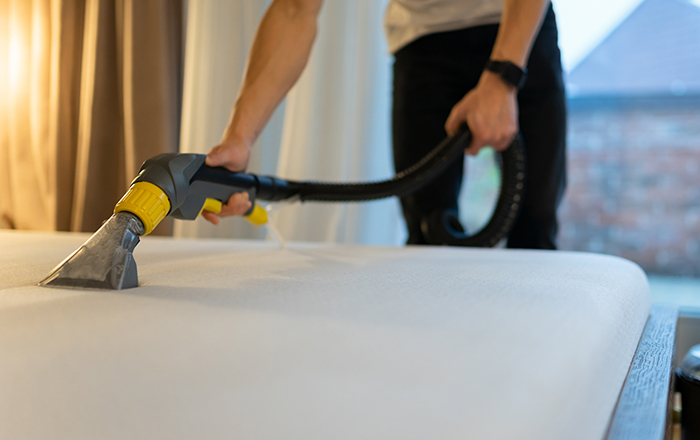Get our independent lab tests, expert reviews and honest advice.
The worst spring cleaning jobs made easy

Winter is finally over and it’s time to let the sunshine in. And while the sunshine is very welcome, it can also reveal just how grubby your house got over winter.
If you’re feeling overwhelmed by all the things that need cleaning, it’s natural to avoid doing the big, messy jobs in favour of crossing smaller items off your spring cleaning list. But there are ways to make the big jobs less painful while still giving you the satisfaction of powering through the chores.
Taking care of key household items will help you enjoy your home in the warmer months and could even save you money in reduced electricity bills and more home-cooked meals.
There are ways to make the big jobs less painful while still giving you the satisfaction of powering through the chores
Our experts sometimes spend hours cleaning appliances as part of their testing, so they know a thing or two about cleaning.
Here are five of the messiest or most boring spring cleaning jobs, and our expert tips on how to make them as easy as possible.
1. Cleaning the barbecue
After months of being stuck inside for meals, you’re probably getting ready for al fresco dining again and planning menus for entertaining.
But most of us don’t think about cleaning the barbecue at the end of the season, so you might find a bit of a mess under the hood the first time you open it in spring.
Before you fire up the barbie for the first time, you’ll want to give it a good clean to get rid of the accumulated grease and dirt that’s been sitting on it all winter.
You actually need the oils from the last time you barbecued to protect your hotplates from rust – but most of us would prefer not to snack on snags cooked in months-old grease.
Spring is the perfect time to give your BBQ a yearly deep clean and check-up to make sure it’s firing on all cylinders for peak barbecue season in summer. If you want to do an in-depth clean and service, we’ve detailed all the steps in our guide to cleaning your barbecue.
But if you just want to get your barbie up and running quickly, here are a few tips:
- Warm up the BBQ then place a stainless steel bowl of water on the racks. Turn the burner to low, close the hood and leave it to do its thing. The steam created will make it easy to wipe the hotplates, side panels and under the hood with a paper towel.
- Scrape food particles and excess oil from the hotplate. You can wipe it over with a paper towel, but don’t remove all the oil – it helps protect the hotplate from rust.
- If it’s so bad that you need to wash the hotplates, put them in a tub of warm soapy water to soak and then give them a scrub and rinse. Once they’re dry, coat them with cooking oil again to protect from rust.
- Clean out the drip tray and replace the absorbent material.
After each time you use your BBQ, give the plates a quick wipe down while they’re still warm so they’re ready for next time.
If you’re feeling extra diligent, you can use the steam cleaning trick above – just pop the bowl of water under the hood while you’re eating and the BBQ will be ready for a quick clean before you move on to dessert.

2. Cleaning your oven
After all the roasts, puddings and other comfort foods we favour in winter, your oven has probably had quite the workout. As we move towards lighter meals and switch from oven to barbecue, it’s a good opportunity to give your oven a thorough clean to clear away grease and debris from all that rich food.
If you’re not up for a deep clean with a caustic oven cleaner (which should only be a last resort anyway), here are some tips to help make spring cleaning easier.
- As with your barbecue, steam is your saviour: it’ll soften the grease and grime, making it easier to wipe away. Once your oven is warm, pop a bowl of hot water onto one of the racks, close the door for a few minutes, then wipe the surfaces with a microfibre cloth or sponge.
- If that doesn’t do the job, you can use a paste of bicarb soda and some water. Spread it around the interior of your oven, steering clear of the heating elements. Let it sit for a few hours (or even overnight), then spray with white vinegar and let it foam up. Wipe out the oven, making sure you remove all of the residue.
- To wash the oven racks, you can pop them in the bath. (Put a towel down first to avoid scratches.) Use warm water and some enzyme-based washing powder, letting them soak for no more than an hour. Run a sponge scourer along each surface, rinse thoroughly and leave to dry. (You can pop them in a 100°C oven for 10 minutes to dry completely.)
If you want all the info on oven cleaning, read our guide to cleaning your oven, including removing and cleaning the oven door.
The best way to make your next spring clean easier is to avoid it getting too grubby in the first place: wipe out spills after each use, and place a tray on the shelf below when cooking foods that can bubble over.
3. Cleaning and servicing your air conditioner
If you haven’t used your air conditioner for heating over winter (here’s why air con is the most efficient way to heat your home), then springtime is a good time to give it a clean and make sure it’s working well before the summer heat hits.

You don’t want to wait until it’s sweltering to find out that the air conditioner is broken and have to wait weeks until you can get someone out to look at it.
Plus, a clean air conditioner is more efficient so it’ll cost you less to run. That’s more money for ice cream and trips to the pool!
You should have your air conditioning system professionally serviced regularly to make sure everything is working as it should. There are some parts of your air conditioner that are best left to the professionals, like the internal components, refrigerant gas and thermostat.
A clean air conditioner is more efficient so it’ll cost you less to run. That’s more money for ice cream and trips to the pool!
But you can take care of cleaning your air conditioner to keep it working well and avoid moisture and even mould building up inside it. Here are the things you can take care of yourself:
- Clean the indoor unit dust filters. Usually, you’ll just need to pop open the plastic cover and remove the filter. Take them outside and give them a brush over and a vacuum. If they’re really nasty, wash them in warm water and mild detergent, then rinse them clean. Make sure they’re completely dry before you put them back in.
- Use a vacuum or dry cloth to clean the louvres, removing them if you can. Clean the space behind the louvres too.
- Wipe down the exterior or ducts/vents with a soft damp cloth.
- Check the outdoor compressor unit. Brush away dust, leaves and cobwebs, and make sure it’s clear of grass or plants. Run a vacuum cleaner over the air intake to clear up any dust.
It goes without saying that you should check your manual before pulling anything off your air conditioner, and to follow the manufacturer’s instructions for cleaning.
4. Wipe over your ceiling fans and switch to summer mode
Whether you’ve been using your ceiling fans over winter to help heat your home (yes, it’s a thing!) or if they’ve been sitting idle during the colder months, now is a good time to give them a clean up so they’re ready for warmer weather.
Just make sure you clean them before it starts getting too warm – you might absent-mindedly flick on the fan on the first warm day and fill the room with a season of accumulated dust bunnies sitting on the blades!
The easiest way to clean the fan blades is to pop pillow cases over each blade. Use the inside of the pillowcase to wipe along the blade – the dust will fall into the pillow case so you won’t need to vacuum afterwards.
A more entertaining way to do it is to put the pillow cases on, then turn the fan on high. As the pillowcase flies off the fan, it will wipe the dust from the blade.
Some ceiling fans have a setting on the remote or wall switch to turn the fan from winter to summer mode, while others have a physical switch on the motor. With some older models, the switch is only accessible by taking the ceiling fan cover off, which can be fiddly.
CHOICE tip: While you have the stepladder out to clean your ceiling fans, it’s a good time to check your smoke alarms too.

5. Cleaning your mattress
It’s pretty gross to think about, but since we spend about a third of our lives in bed, our mattresses can accumulate some serious gunk, such as sweat, drool, dead skin cells, dust and the like.
If you’re switching heavy winter bedding for a lighter doona in spring, you might as well clean your mattress while you’re at it.
While you can go all-out and have your mattress professionally cleaned, or drag it out into the sunshine to sanitise it, here’s how you can make it feel fresher with not much effort:
- Vacuum the mattress surface (top and sides) using your vacuum’s upholstery cleaner.
- Sprinkle some bicarb soda across the surface of the mattress and leave it for a few hours. (If there’s a way you can leave it for 24 hours or more, that’s great, but a few hours is better than nothing.)
- Vacuum the mattress one more time to suck up the bicarb.
It’s a good idea to flip or rotate your mattress regularly to prevent grooves and sagging. (Just don’t flip the mattress if it has a pillow top.)
Other quick spring cleaning hacks
- Washing machine: Run an empty cycle on the hottest setting with a bit of detergent. Leave the door ajar in between cycles so it can dry out, and wipe out the seals after each cycle to prevent mould.
- Dishwasher: Put two cups of vinegar in a bowl in the bottom rack of your empty dishwasher, pausing the cycle halfway through to give it a chance to soak.
- Microwave: Put a small bowl of water with some vinegar or fresh lemon in the microwave, run it for three minutes then leave the door closed for five minutes to let the steam loosen any residue. Open the door, remove the bowl and wipe all the surfaces.
- Vacuum: Remove and clean the filter (and replace if necessary) and remove everything you can – hose, wand, dust bin, accessory heads – and give them a wipe over or a proper wash if needed. Remove any hair or threads tangled around the roller.
- Fridge: pull the fridge away from the wall and get rid of any dust or cobwebs on both the wall and any external condenser coils. Check the evaporator tray, and vacuum the floor under where the fridge sits.






